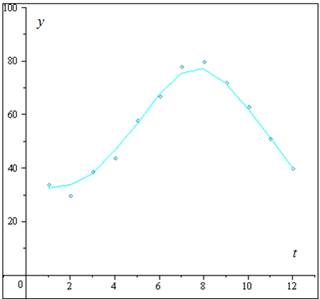
(a)
To calculate : The value of
(a)
Answer to Problem 24E
The value of
Explanation of Solution
Given information:
The table given below gives the average monthly temperatures in St. Louis for a
| Time (Months) | Temperature |
Calculation:
It is given that period is
Hence,
(b)
To calculate : Relation between the amplitude
(b)
Answer to Problem 24E
Relation between the amplitude
Explanation of Solution
Given information:
The table given below gives the average monthly temperatures in St. Louis for a
| Time (Months) | Temperature |
Calculation:
It is half of the difference,
So
(c)
To calculate : The value of
(c)
Answer to Problem 24E
The value of
Explanation of Solution
Given information:
The table given below gives the average monthly temperatures in St. Louis for a
| Time (Months) | Temperature |
Calculation:
It is the average of the minimum and maximum temperatures.
So,
(d)
To calculate : The value of
(d)
Answer to Problem 24E
The value of
Explanation of Solution
Given information:
The table given below gives the average monthly temperatures in St. Louis for a
| Time (Months) | Temperature |
Calculation:
The function should have its minimum at
Hence the value
Hence the equation can be written as
(e)
To graph : The equation for
(e)
Explanation of Solution
Given information:
The table given below gives the average monthly temperatures in St. Louis for a
| Time (Months) | Temperature |
Graph:
The graph of the equation is:

Interpretation:
The domain is
Chapter 0 Solutions
AP CALCULUS TEST PREP-WORKBOOK
- Consider the following system of equations, Ax=b : x+2y+3z - w = 2 2x4z2w = 3 -x+6y+17z7w = 0 -9x-2y+13z7w = -14 a. Find the solution to the system. Write it as a parametric equation. You can use a computer to do the row reduction. b. What is a geometric description of the solution? Explain how you know. c. Write the solution in vector form? d. What is the solution to the homogeneous system, Ax=0?arrow_forward2. Find a matrix A with the following qualities a. A is 3 x 3. b. The matrix A is not lower triangular and is not upper triangular. c. At least one value in each row is not a 1, 2,-1, -2, or 0 d. A is invertible.arrow_forwardFind the exact area inside r=2sin(2\theta ) and outside r=\sqrt(3)arrow_forward
- A 20 foot ladder rests on level ground; its head (top) is against a vertical wall. The bottom of the ladder begins by being 12 feet from the wall but begins moving away at the rate of 0.1 feet per second. At what rate is the top of the ladder slipping down the wall? You may use a calculator.arrow_forwardExplain the focus and reasons for establishment of 12.4.1(root test) and 12.4.2(ratio test)arrow_forwarduse Integration by Parts to derive 12.6.1arrow_forward
- Explain the relationship between 12.3.6, (case A of 12.3.6) and 12.3.7arrow_forwardExplain the key points and reasons for the establishment of 12.3.2(integral Test)arrow_forwardUse 12.4.2 to determine whether the infinite series on the right side of equation 12.6.5, 12.6.6 and 12.6.7 converges for every real number x.arrow_forward
 Calculus: Early TranscendentalsCalculusISBN:9781285741550Author:James StewartPublisher:Cengage Learning
Calculus: Early TranscendentalsCalculusISBN:9781285741550Author:James StewartPublisher:Cengage Learning Thomas' Calculus (14th Edition)CalculusISBN:9780134438986Author:Joel R. Hass, Christopher E. Heil, Maurice D. WeirPublisher:PEARSON
Thomas' Calculus (14th Edition)CalculusISBN:9780134438986Author:Joel R. Hass, Christopher E. Heil, Maurice D. WeirPublisher:PEARSON Calculus: Early Transcendentals (3rd Edition)CalculusISBN:9780134763644Author:William L. Briggs, Lyle Cochran, Bernard Gillett, Eric SchulzPublisher:PEARSON
Calculus: Early Transcendentals (3rd Edition)CalculusISBN:9780134763644Author:William L. Briggs, Lyle Cochran, Bernard Gillett, Eric SchulzPublisher:PEARSON Calculus: Early TranscendentalsCalculusISBN:9781319050740Author:Jon Rogawski, Colin Adams, Robert FranzosaPublisher:W. H. Freeman
Calculus: Early TranscendentalsCalculusISBN:9781319050740Author:Jon Rogawski, Colin Adams, Robert FranzosaPublisher:W. H. Freeman
 Calculus: Early Transcendental FunctionsCalculusISBN:9781337552516Author:Ron Larson, Bruce H. EdwardsPublisher:Cengage Learning
Calculus: Early Transcendental FunctionsCalculusISBN:9781337552516Author:Ron Larson, Bruce H. EdwardsPublisher:Cengage Learning





